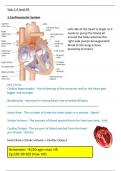Summary
Summary A Level PE - Anatmoy and Physiology + Biomechanical Movement
- Institution
- AQA
This is a summary of the entire A Level Physical Education Anatomy and Physiology and Biomechanical movement modules... that got me a 9 at A level. It contains statistics and case studies while leaving space for academic drawings to facilitate revision.
[Show more]



